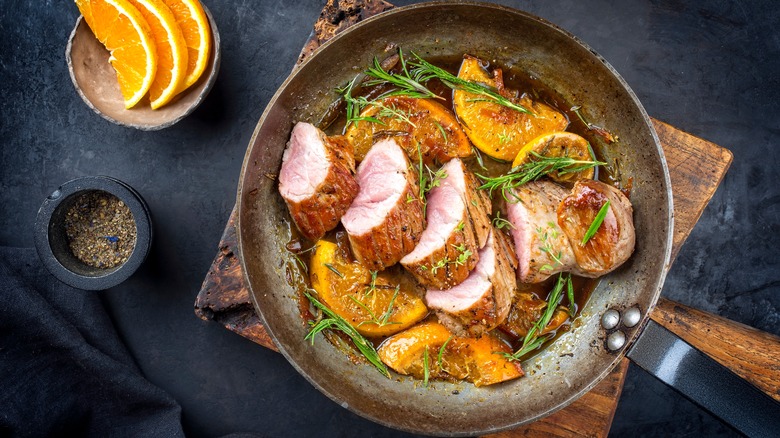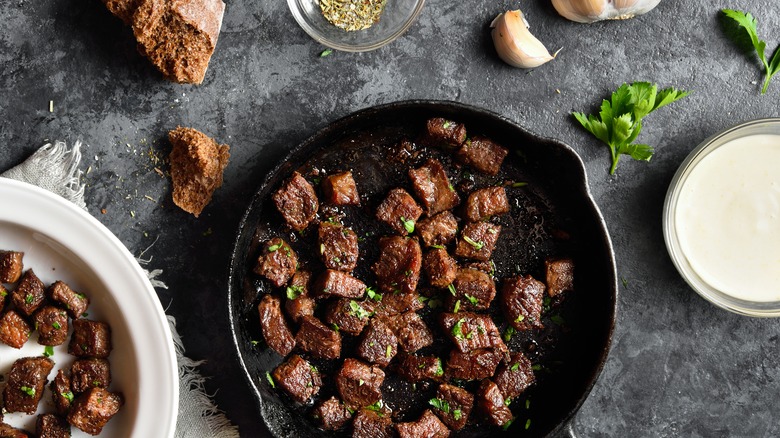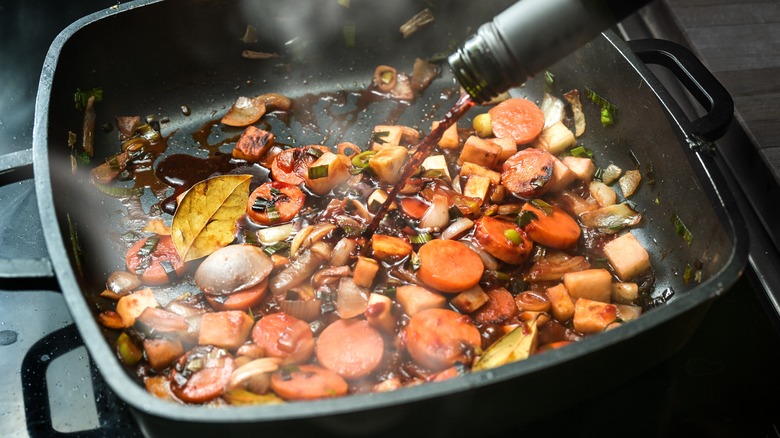Upgrade Your Pan Sauces And Avoid Nonstick Skillets
While there are many secrets for elevating your pan sauce, starting with the wrong piece of cookware can be the difference between success and tragedy. Pan sauces are a quick way to bring added depth to dishes using the flavor left over from cooking proteins and/or vegetables. Nonstick skillets are meant to make cooking and cleanup a breeze, but when it comes to crafting a delicious sauce, sticking is essential.
If you've ever pan-seared a steak or sauteed ground beef, you may have noticed the little brown bits that get left behind once you remove the meat from the pan. Those magical morsels are not to be discarded — they're the key to a powerful, flavorful pan sauce. If you use a nonstick skillet, however, not only will your meat miss out on a desirable, even sear, but none of those flavorful bits will remain tethered to the bottom, as the whole point of this type of pan is to prevent sticking. And when you add in your deglazing liquid, you'll just create a bland, watered-down mixture instead of a rich pan sauce. To get the best of those browned bits, you're going to have to avoid using a nonstick skillet and bust out a different kind of metal pan.
It's all about the fond
But what are those small browned bits that stick to the bottom of the pan? They have a fancy culinary name from the French: Fond. Fond translates from French to mean "base," an apt name as it is crucial to whipping up a flavorful pan sauce. The fond is the golden-brown, crispy result of the Maillard reaction occurring between the pan, your cooking fat (usually oil or butter), and the food you've seared (whether meat or vegetable). To have the best chance of creating fond, you'll want to use stainless steel cookware or cast-iron cookware. These pans are made to handle high heat and efficiently brown up whatever you're cooking.
The reason stainless steel is so effective at browning foods is all in the science — iron atoms in the stainless steel pan create bonds with the amino acids from the surface of the food, like the skin of a chicken thigh or the outer edges of a vegetable. If you want to encourage even more sticking or browning, you can even reduce the amount of oil added to the pan. This reduces the barrier between the food's surface and the pan, ensuring you'll have plenty of sticky fond left over.
Other tips for creating a delicious pan sauce
In every step of making a pan sauce, make sure you're always keeping a close eye on the pan. You don't want the fond to overcook and burn. Once your meat or vegetables are removed, deglaze the pan while the pan is still hot. Just keep in mind that using more acidic liquids like vinegar to deglaze could ruin your pan's natural seasoning — chicken or vegetable broth is a safer bet. Use a wooden spatula to scrape up every last brown bit and let the mixture come to a boil and simmer so the flavors can really start to meld. Lowering the heat and adding butter at the very end is another key to thickening up your sauce so it's not so watery.
Delicious pan sauces are the key to elevating one-pan meals as quickly and easily as possible. Crispy chicken pairs great with a homemade white wine pan sauce, or you can get creative with different herbs you add to infuse the pan sauce while it simmers. These herbs can be the usual sprig of thyme or a few bay leaves, or you can experiment with adding Earl Grey tea bags to your pan sauce or other unique ingredients. You'll be starting with a good foundation of flavor, so you can let the imagination run wild. That extra bit of cleanup from avoiding a nonstick skillet is worth the flavor payoff that delicious fond brings to any pan sauce.


